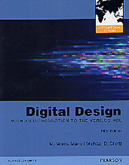Digital Design and Computer Architecture (Paperback)
暫譯: 數位設計與電腦架構 (平裝本)
David Harris, Sarah Harris
- 出版商: Morgan Kaufmann
- 出版日期: 2007-03-16
- 售價: $1,007
- 語言: 英文
- 頁數: 592
- 裝訂: Paperback
- ISBN: 0123704979
- ISBN-13: 9780123704979
已過版
買這商品的人也買了...
-
 深入淺出設計模式 (Head First Design Patterns)
深入淺出設計模式 (Head First Design Patterns)$880$695 -
 遊戲人工智慧 (AI for Game Developers)
遊戲人工智慧 (AI for Game Developers)$680$537 -
 SQL 語法範例辭典
SQL 語法範例辭典$550$435 -
 Microsoft Office SharePoint Server 2007 新一代企業 Web 解決方案(第一集)
Microsoft Office SharePoint Server 2007 新一代企業 Web 解決方案(第一集)$690$587 -
 Linux 驅動程式, 3/e (Linux Device Drivers, 3/e)
Linux 驅動程式, 3/e (Linux Device Drivers, 3/e)$980$774 -
 嵌入式設計及 Linux 驅動開發指南─基於 ARM9 處理器, 2/e
嵌入式設計及 Linux 驅動開發指南─基於 ARM9 處理器, 2/e$420$399 -
 微軟 Windows Presentation Foundation 程式設計指南 (Applications = Code + Markup: A Guide to the Microsoft Windows Presentation Foundation)
微軟 Windows Presentation Foundation 程式設計指南 (Applications = Code + Markup: A Guide to the Microsoft Windows Presentation Foundation)$760$600 -
 Linux 核心詳解, 3/e (Understanding the Linux Kernel, 3/e)
Linux 核心詳解, 3/e (Understanding the Linux Kernel, 3/e)$1,200$948 -
 Photoshop 點子爆米花
Photoshop 點子爆米花$580$458 -
 寫給 SA 的 UML/MDA 實務手冊
寫給 SA 的 UML/MDA 實務手冊$350$298 -
 精通 Java 網路程式
精通 Java 網路程式$625$563 -
 深入淺出物件導向分析與設計 (Head First Object-Oriented Analysis and Design)
深入淺出物件導向分析與設計 (Head First Object-Oriented Analysis and Design)$880$695 -
 ActionScript 3.0 精緻範例辭典
ActionScript 3.0 精緻範例辭典$550$435 -
 ASP.NET AJAX 應用剖析立即上手
ASP.NET AJAX 應用剖析立即上手$580$452 -
 PCI Express 系統架構 (PCI Express System Architecture)
PCI Express 系統架構 (PCI Express System Architecture)$880$695 -
 軟體測試實務講座─來自矽谷的技術經驗與心得分享
軟體測試實務講座─來自矽谷的技術經驗與心得分享$290$226 -
 JavaScript 大全 (JavaScript: The Definitive Guide, 5/e)
JavaScript 大全 (JavaScript: The Definitive Guide, 5/e)$1,200$948 -
 現代嵌入式系統開發專案實務-菜鳥成長日誌與專案經理的私房菜
現代嵌入式系統開發專案實務-菜鳥成長日誌與專案經理的私房菜$600$480 -
 軟體建構之道 (Code Complete, 2/e)
軟體建構之道 (Code Complete, 2/e)$1,200$1,020 -
 FPGA Prototyping by VHDL Examples: Xilinx Spartan-3 Version (Hardcover)
FPGA Prototyping by VHDL Examples: Xilinx Spartan-3 Version (Hardcover)$1,850$1,813 -
 深入淺出 C# (Head First C#)
深入淺出 C# (Head First C#)$980$774 -
 PMP Exam Prep: Rita's Course in a Book for Passing the PMP Exam, 6/e (Paperback)
PMP Exam Prep: Rita's Course in a Book for Passing the PMP Exam, 6/e (Paperback)$3,200$3,040 -
 Google Android 手機 APP 開發入門
Google Android 手機 APP 開發入門$520$442 -
 數位邏輯設計 (Logic and Computer Design Fundamentals, 4/e)
數位邏輯設計 (Logic and Computer Design Fundamentals, 4/e)$550$523 -
 PIC Easy Go !! ─簡單使用 PIC
PIC Easy Go !! ─簡單使用 PIC$500$450
商品描述
Description
Digital Design and Computer Architecture is designed for courses that combine digital logic design with computer organization/architecture or that teach these subjects as a two-course sequence. Digital Design and Computer Architecture begins with a modern approach by rigorously covering the fundamentals of digital logic design and then introducing Hardware Description Languages (HDLs). Featuring examples of the two most widely-used HDLs, VHDL and Verilog, the first half of the text prepares the reader for what follows in the second: the design of a MIPS Processor. By the end of Digital Design and Computer Architecture, readers will be able to build their own microprocessor and will have a top-to-bottom understanding of how it works--even if they have no formal background in design or architecture beyond an introductory class. David Harris and Sarah Harris combine an engaging and humorous writing style with an updated and hands-on approach to digital design.
Table of Contents
1 From Zero to One
1.1 The Game Plan
1.2 The Art of Managing Complexity
1.3 The Digital Abstraction
1.4 Number Systems
1.5 Logic Gates
1.6 Logic Levels
1.7CMOS Transistors
1.8Power Consumption
1.9 Summary and A Look Ahead
2 Combinational Logic Design
2.1 Introduction
2.2 Boolean Equations
2.3 Boolean Algebra
2.4 From Logic to Gates
2.5 Multilevel Combinational Logic
2.6 X's and Z's, Oh My
2.7 Karnaugh Maps
2.8 Combinational Building Blocks
2.9 Timing
2.10 Summary
3 Sequential Logic Design
3.1 Introduction
3.2 Latches and Flip-Flops
3.3 Synchronous Logic Design
3.4 Finite State Machines
3.5 Timing of Sequential Logic
3.6 Parallelism
3.7 Summary
4 Hardware Description Languages
4.1 Introduction
4.2 Combinational Logic
4.3 Structural Modeling
4.4 Sequential Logic
4.5 More Combinational Logic
4.6 Finite State Machines
4.7Parameterized Modules
4.8 Testbenches
4.9 Summary
5 Digital Building Blocks
5.1 Introduction
5.2 Arithmetic Circuits
5.3 Number Systems
5.4 Sequential Building Blocks
5.5 Memory Arrays
5.6 Logic Arrays
5.7 Summary
6 Architecture
6.1 Introduction
6.2 Assembly Language
6.3 Machine Language
6.4 Programming
6.5 Addressing Modes
6.6 Lights, Camera, Action: Compiling, Assembling, and Loading
6.7Odds and Ends
6.8Real World Perspective: IA-32 Architecture
6.9 Summary
7 Microarchitecture
7.1 Introduction
7.2 Performance Analysis
7.3 Single-Cycle Processor
7.4 Multicycle Processor
7.5 Pipelined Processor
7.6HDL Representation
7.7Exceptions
7.8Advanced Microarchitecture
7.9Real World Perspective: IA-32 Microarchitecture
7.10 Summary
8 Memory Systems
8.1 Introduction
8.2 Memory System Performance Analysis
8.3 Caches
8.4 Virtual Memory
8.5Memory-Mapped I/O
8.6Real World Perspective: IA-32 Memory and I/O Systems
8.7 Summary
Appendix A Digital System Implementation
A.1 Introduction
A.2 74xx Logic
A.3 Programmable Logic
A.4 Application-Specific Integrated Circuits
A.5 Data Sheets
A.6 Logic Families
A.7 Packaging and Assembly
A.8 Transmission lines
A.9 Economics
Appendix B MIPS Instructions
商品描述(中文翻譯)
**描述**
《數位設計與電腦架構》是為結合數位邏輯設計與電腦組織/架構的課程而設計,或是將這些主題作為兩門課程序列教授的課程。《數位設計與電腦架構》以現代方法開始,嚴謹地涵蓋數位邏輯設計的基本原理,然後介紹硬體描述語言(Hardware Description Languages, HDLs)。本書前半部分以兩種最廣泛使用的HDL,即VHDL和Verilog為例,為讀者準備接下來的內容:MIPS處理器的設計。在《數位設計與電腦架構》的結尾,讀者將能夠構建自己的微處理器,並對其運作有全面的理解——即使他們在設計或架構方面的正式背景僅限於入門課程。David Harris和Sarah Harris結合了引人入勝且幽默的寫作風格,並採用更新且實用的數位設計方法。
**目錄**
1 從零到一
1.1 遊戲計畫
1.2 管理複雜性的藝術
1.3 數位抽象
1.4 數字系統
1.5 邏輯閘
1.6 邏輯電平
1.7 CMOS晶體管
1.8 功耗
1.9 總結與展望
2 組合邏輯設計
2.1 介紹
2.2 布爾方程
2.3 布爾代數
2.4 從邏輯到閘
2.5 多層組合邏輯
2.6 X和Z,哦我的天
2.7 卡諾圖
2.8 組合建構塊
2.9 時序
2.10 總結
3 序列邏輯設計
3.1 介紹
3.2 鎖存器和觸發器
3.3 同步邏輯設計
3.4 有限狀態機
3.5 序列邏輯的時序
3.6 並行性
3.7 總結
4 硬體描述語言
4.1 介紹
4.2 組合邏輯
4.3 結構建模
4.4 序列邏輯
4.5 更多組合邏輯
4.6 有限狀態機
4.7 參數化模組
4.8 測試平台
4.9 總結
5 數位建構塊
5.1 介紹
5.2 算術電路
5.3 數字系統
5.4 序列建構塊
5.5 記憶體陣列
5.6 邏輯陣列
5.7 總結
6 架構
6.1 介紹
6.2 組合語言
6.3 機器語言
6.4 程式設計
6.5 位址模式
6.6 燈光、攝影、行動:編譯、組合和加載
6.7 雜項
6.8 現實世界觀點:IA-32架構
6.9 總結
7 微架構
7.1 介紹
7.2 性能分析
7.3 單週期處理器
7.4 多週期處理器
7.5 流水線處理器
7.6 HDL表示
7.7 異常
7.8 進階微架構
7.9 現實世界觀點:IA-32微架構
7.10 總結
8 記憶體系統
8.1 介紹
8.2 記憶體系統性能分析
8.3 快取
8.4 虛擬記憶體
8.5 記憶體映射I/O
8.6 現實世界觀點:IA-32記憶體和I/O系統
8.7 總結
附錄A 數位系統實現
A.1 介紹
A.2 74xx邏輯
A.3 可程式邏輯
A.4 特定應用集成電路
A.5 數據表
A.6 邏輯系列
A.7 包裝與組裝
A.8 傳輸線
A.9 經濟學
附錄B MIPS指令



























